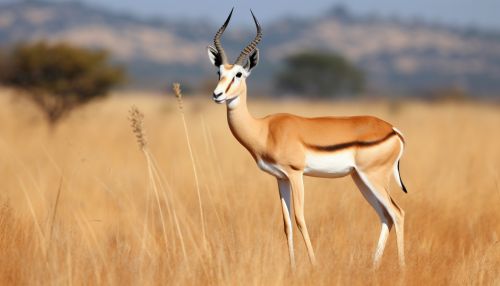Springbok
Taxonomy and Evolution
The Springbok (Antidorcas marsupialis) is a medium-sized antelope found mainly in southern and southwestern Africa. The sole member of the genus Antidorcas, this bovid was first described by the German zoologist Eberhard August Wilhelm von Zimmermann in 1780. The springbok is characterized by a white face, a dark stripe running from the eyes to the mouth, a light-brown coat marked by a reddish-brown stripe that runs from the upper foreleg to the buttocks across the flanks like the gazelle, and a white rump flap.


Description
Springboks exhibit a form of sexual dimorphism, with the males being slightly larger and heavier than the females. Adult males usually weigh 33–50 kg (73–110 lb), while the females weigh 26–40 kg (57–88 lb). Both sexes have a pair of black, 35–50 cm (14–20 in) long horns that curve backwards. The springbok, like other antelopes, has a pouch of skin, known as a dewlap, that starts at the base of the neck and extends down the middle of the chest area. The springbok also has a unique pouch on the back in which the white hairs are hidden; this feature, called a dorsal fold, opens up when the springbok starts jumping.
Behaviour and Ecology
Springboks are primarily browsers and may switch to grazing occasionally; they feed on shrubs and succulents; this antelope can live without drinking water for years, meeting its requirements through eating succulent vegetation. Springboks form harems (mixed-sex herds). In earlier times, springboks of the Kalahari desert and Karoo migrated in large numbers across the countryside, a practice known as trekking. The springbok is known for its unique pronking display, in which it performs multiple leaps into the air, up to 2 m (6.6 ft) above the ground, in a stiff-legged posture, with the dorsal fold raised.
Distribution and Habitat
The springbok inhabits the dry areas of south and southwestern Africa. The International Union for Conservation of Nature and Natural Resources classifies the springbok as a Least Concern species. There are no threats to the survival of the springbok, and it is of little concern to conservationists. The springbok is a national symbol of South Africa and is the name of the national rugby team.
